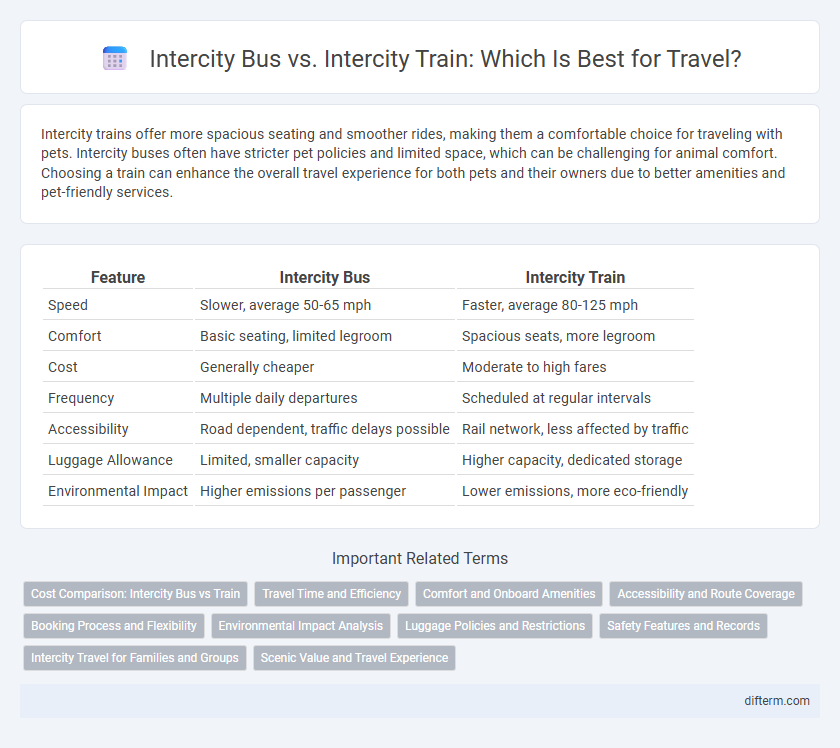Intercity trains offer more spacious seating and smoother rides, making them a comfortable choice for traveling with pets. Intercity buses often have stricter pet policies and limited space, which can be challenging for animal comfort. Choosing a train can enhance the overall travel experience for both pets and their owners due to better amenities and pet-friendly services.
Table of Comparison
| Feature | Intercity Bus | Intercity Train |
|---|---|---|
| Speed | Slower, average 50-65 mph | Faster, average 80-125 mph |
| Comfort | Basic seating, limited legroom | Spacious seats, more legroom |
| Cost | Generally cheaper | Moderate to high fares |
| Frequency | Multiple daily departures | Scheduled at regular intervals |
| Accessibility | Road dependent, traffic delays possible | Rail network, less affected by traffic |
| Luggage Allowance | Limited, smaller capacity | Higher capacity, dedicated storage |
| Environmental Impact | Higher emissions per passenger | Lower emissions, more eco-friendly |
Cost Comparison: Intercity Bus vs Train
Intercity bus travel typically offers lower ticket prices compared to intercity trains, making buses a budget-friendly option for cost-conscious travelers. Train fares, while often higher, provide faster travel times and more comfortable amenities, which can justify the additional expense for some passengers. When comparing total travel costs, factors such as luggage fees, seat reservations, and on-board services should be considered to determine the best value between bus and train options.
Travel Time and Efficiency
Intercity trains typically offer faster travel times compared to buses due to higher average speeds and fewer stops, significantly reducing overall journey duration. Trains run on dedicated tracks, minimizing delays caused by road traffic congestion, which often affects intercity bus schedules. Efficient boarding and disembarking processes on trains also contribute to smoother travel experiences, enhancing overall time efficiency for long-distance travelers.
Comfort and Onboard Amenities
Intercity trains often provide superior comfort with spacious seating, smooth rides, and more legroom compared to buses. Train amenities typically include Wi-Fi, power outlets, dining cars, and restrooms, enhancing passenger convenience during travel. Buses may offer basic onboard features like air conditioning and reclining seats but generally lack the extensive services available on trains.
Accessibility and Route Coverage
Intercity buses offer extensive route coverage, reaching rural and less accessible areas where train tracks may not extend, making them a versatile option for travelers in remote regions. Trains provide enhanced accessibility for passengers with mobility challenges, featuring level boarding and dedicated spaces for wheelchairs, ensuring a comfortable journey. While buses cover a broader network, trains excel in providing consistent accessibility features and smoother rides across major city connections.
Booking Process and Flexibility
Intercity train bookings often offer greater flexibility with options for refundable tickets and easy date changes, while intercity bus reservations typically require earlier commitment and have stricter cancellation policies. Most train services provide online platforms with real-time seat selection and dynamic pricing, enhancing user convenience compared to bus operators that may rely on limited online availability or in-person ticketing. The seamless booking systems of rail companies support last-minute travel adjustments, making them preferable for travelers seeking adaptable schedules.
Environmental Impact Analysis
Intercity trains generally have a lower environmental impact than intercity buses, producing fewer greenhouse gas emissions per passenger kilometer due to higher energy efficiency and electrification options. Trains reduce air pollution and noise pollution more effectively, benefiting urban and rural areas along their routes. Buses, while flexible in route adjustments, contribute more to carbon dioxide emissions, particularly when powered by diesel engines.
Luggage Policies and Restrictions
Intercity bus services typically enforce strict luggage limits, often allowing one carry-on and one checked bag with size and weight restrictions, while additional fees may apply for excess baggage. Intercity trains usually offer more generous luggage allowances, permitting multiple bags without extra charges and accommodating oversized items more easily due to larger storage areas. Travelers prioritizing ease of luggage handling and fewer restrictions often find trains a more convenient choice for intercity journeys.
Safety Features and Records
Intercity trains consistently demonstrate superior safety features, including advanced signaling systems, automated braking technology, and rigorous track maintenance protocols, resulting in lower accident rates compared to intercity buses. Bus safety largely depends on driver skill and road conditions, with varying safety standards across regions and higher incidents of collisions and rollovers reported globally. Statistical data from the National Highway Traffic Safety Administration (NHTSA) and International Union of Railways (UIC) confirm trains have significantly fewer fatalities per billion passenger kilometers traveled than buses.
Intercity Travel for Families and Groups
Intercity trains offer families and groups spacious seating, onboard amenities, and a smoother ride, enhancing comfort during long journeys. Buses provide more flexible routes and often lower ticket prices, making them cost-effective for budget-conscious travelers. Both options accommodate luggage allowances and group discounts, with train stations typically providing easier access to city centers compared to bus terminals.
Scenic Value and Travel Experience
Traveling by intercity train offers passengers expansive panoramic views of landscapes, providing a more immersive scenic experience than most intercity buses, which often follow highways with limited vistas. Trains typically feature larger windows and smoother rides, enhancing comfort and the ability to appreciate natural surroundings, while buses may navigate more congested routes with frequent stops that can disrupt the travel flow. For travelers prioritizing visual enjoyment and a relaxed journey, intercity trains present a superior option for appreciating diverse terrains and regional beauty.
intercity bus vs intercity train Infographic

 difterm.com
difterm.com